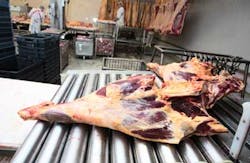Over the past few years the average meat consumption per capita in Canada has been falling, leading to a decline in the country's meat, beef and poultry processing industry. The trend can be detected both in export volumes and in employment, industry research firm IBISWorld stated in its latest report on the state of Canadian meat and poultry industry.
However, IBISWorld noted that as the national economy has generally recovered and is back on the path to growth, improved consumer sentiment is also expected. This is likely to result in increased industry revenue over the next five years, the report stated.
The industry is one of the key parts of Canada's food processing industry. It accounts for about 10 percent of the total export of agriculture and food products and employs about 66,500 workers across the country. In light of its prominence and significant contribution to the economy, the decline experienced in recent years has been concerning. IBISWorld industry analyst Agiimaa Kruchkin commented that the bleak picture resulted from lower consumer confidence and decreased meat and poultry consumption driven by a number of factors.
A series of foodborne disease outbreaks linked to meat and poultry was one of the main reasons for falling consumption. The outbreak that had the biggest impact on the industry occurred in 2009, when the global swine flu pandemic played a significant role in shrinking the market, reducing downstream demand from wholesale trade by as much as 15 percent. As a result, industry revenue dropped to $24 billion in the five years leading up to 2013, falling at an average annual rate of 0.2 percent, the report said.
RELATED: Food manufacturers focus on new products in 2013
At the same time, health organizations' campaigns have been trying to raise awareness of the health risks linked to red meat consumption. Over the five years to 2013 consumers have become increasingly conscious about the risks associated with the consumption of pork and beef, including obesity, heart disease and certain types of cancer. As a result, a significant number of consumers have shifted their preference to more healthy sources of protein, such as poultry, fish, seafood, soy meats and beans. This has fueled steady demand in the poultry sector, which has balanced the state of the overall industry to a certain extent, IBISWorld found.
However, as meat is still a favorite food category for the majority of Canadian consumers, an expected boost in disposable income in 2013 is predicted to lead to a rise in revenue of 0.6 percent, the report pointed out. Kruchkin added that downstream demand is likely to recover to levels seen before the economic downturn over the next five years but there are other challenges to be taken into account. The impact of potential disease outbreaks and changing weather conditions could result in industry volatility. In an attempt to reduce the adverse effect of these factors, meat and poultry processors are likely to focus on technological improvements that can boost efficiencies, the report concluded.
